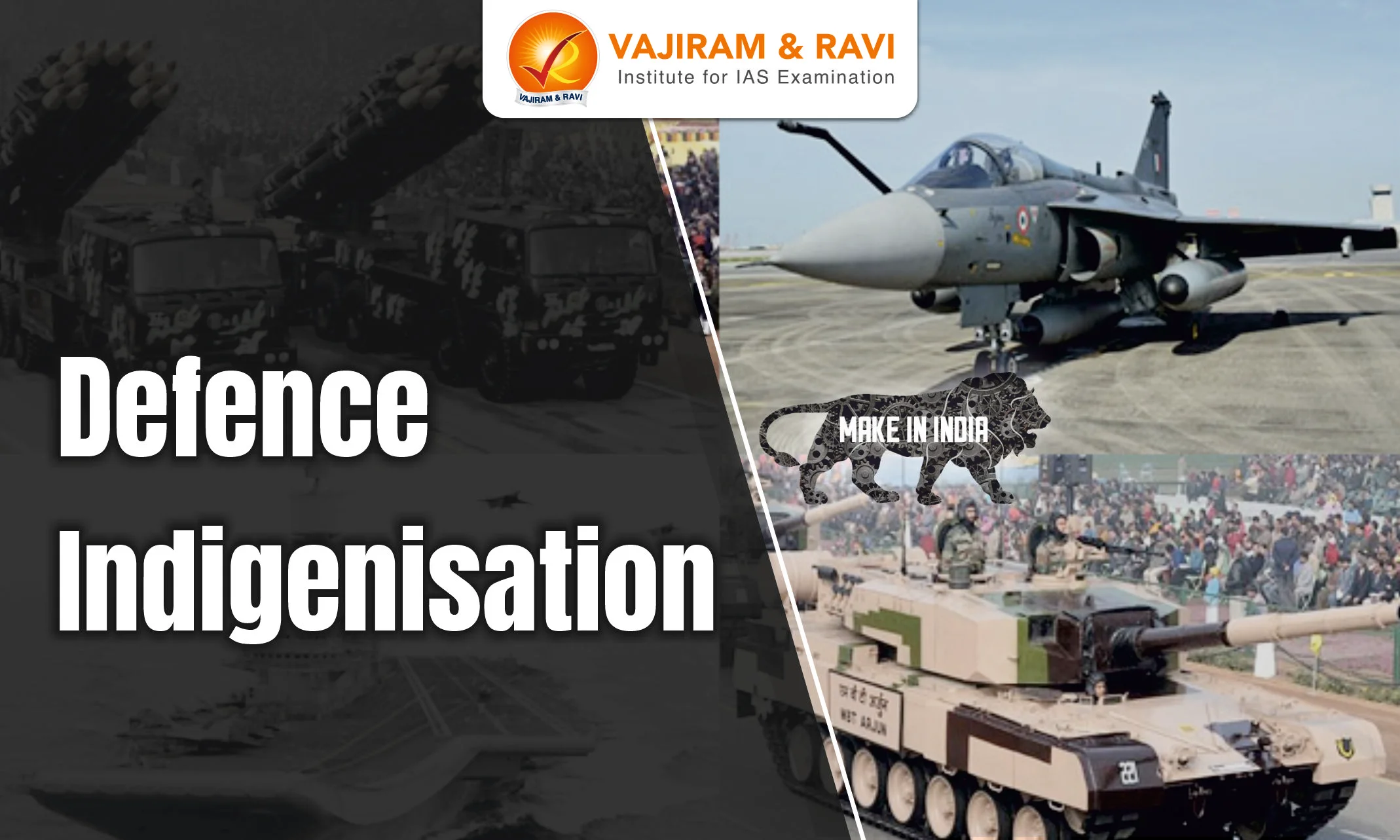Defence indigenisation refers to the strategic objective of a country to develop and enhance its own industrial and technological capabilities for producing essential defence equipment and systems. This approach aims to reduce dependency on foreign sources for military hardware, ensuring self-sufficiency in meeting the national security requirements.
The ultimate goal is to establish a robust defence industry that can design, develop, and manufacture a wide range of military equipment, from basic arms and ammunition to advanced weapon systems and platforms.
Background of Defence Indigenisation in India
India's journey toward defence indigenisation is characterised by a significant defence budget, a substantial defence industrial establishment, and a history of defence production.
- Early Recognition of Need (1950s-1970s): India recognised the need to reduce dependence on foreign sources, India took steps toward indigenisation, stimulated by the Wars of 1962, 1965, and 1971.
- Integrated Guided Missile Development Programme (IGMDP), 1983: It aimed at developing strategic missile systems. Under Abdul Kalam's leadership, it concluded in 2008, boosting India's indigenous missile capabilities.
- Self-Reliance Index and Abdul Kalam's Initiative (1992): In 1992, with a low Self-Reliance Index (ratio of indigenous content of defence procurements to the total expenditure on defence procurements in a financial year) of 0.3, Abdul Kalam formed a committee to create a 10-year plan, targeting an SRI of 0.7 by 2005.
- Responsibility Transfer (2000s): Responsibility for indigenisation shifted from the Department of Defence Production (DDP) and Directorate General of Quality Assurance (DGQA) to the Ordnance Factories Board (OFB) and Services. The Army and Navy devised 15-year Perspective Plans for Indigenisation.
- Defence Procurement Procedure (DPP): There have been continuous developments and evolution of DPP from 2001 onwards.
- Project 75 (1997): It focused on indigenous submarine development, emphasising self-reliance in submarine construction to reduce dependence on foreign sources.
Need for Defence Indigenisation
India's goal of defence indigenisation is based on several aspects.
- India’s Share in Global Arms Market: India's share in the global arms exports market is minimal, accounting for only 0.2 per cent which goes against India’s Balance of Payments.
- SIPRI reports indicate that India ranked 23rd during the period 2017-21, with a marginal presence in the global arms market.
- India as the Largest Importer of Arms: Despite efforts to promote domestic production and reduce imports, India remains the largest importer of arms in the world, accounting for 11 per cent of global arms imports during 2018-22.
- Development of Military Industrial Complex: It is a network of individuals and institutions involved in the production of weapons and military technologies.
- It aims to increase military spending by the national government and its establishment is necessary, ensuring self-reliance and reducing dependence on foreign sources.
- Technology Transfer and Independence: It allows the nation to develop and maintain critical defence capabilities by facilitating technology transfer through foreign collaborations.
- Exports: With the increasing defence indigenisation, India can widen its export base.
- For example, India is in the process of exporting Brahmos Cruise Missiles to the Philippines.
- Research and Development: Defence indigenisation promotes substantial investments in research and development (R&D) contributing to the growth of a defence industrial ecosystem in India and spin-off effects on other manufacturing sectors.
Government’s Initiative towards Defence Indigenisation
The Government has taken several policy initiatives in the past few years and brought in reforms to encourage indigenous design, development and manufacture of defence equipment, thereby promoting self-reliance in defence manufacturing & technology in the country.
- Defence Procurement Policy, 2016:
- It was based on Dhirendra Singh committee recommendations and includes the "Buy (Indian-IDDM)" category.
- It empowered the Defence Acquisition Council with a "fast-track" route for acquiring weapons.
- Innovations for Defence Excellence (iDEX), 2018 or iDEX Prime, 2022:
- It engages industries, especially MSMEs, start-ups, individual innovators, research and development (R&D) institutes, and academia.
- iDEX provides grants, funding, and support for innovations and R&D.
- SPRINT Challenges:
- The Naval Innovation and Indigenisation Organisation (NIIO) introduced the SPRINT initiative in 2022 in collaboration with the Defence Innovation Organisation (DIO).
- It aims to integrate at least 75 new indigenous technologies/products into the Indian Navy under the SPRINT project.
- Indigenous Manufacturing:
- To streamline the industrial landscape, the government has undertaken significant measures.
- These include simplification of the industrial licensing process, extending validity periods and liberalising FDI policy allowing up to 74% FDI under the automatic route.
- The share of domestic procurement in the total procurement has seen a significant uptrend i.e., 54% in 2018-19, 59% in 2019-20, 64% in 2020-21, and a significant increase to 68% in the current year with 25% earmarked for private industry.
- There is a substantial reduction in defence procurement from foreign sources i.e., from 46% to 36% in the last four years (2018-19 to 2021-22).
- Defence Industrial Corridors: The government has established two Defence Industrial Corridors, one each in Uttar Pradesh and Tamil Nadu recognizing the significance of regional hubs for aerospace and defence.
- Positive Indigenisation Lists: It prioritises procurement from domestic sources, specifically under the Buy Indian (IDDM) category with embargoes on imports.
- E-Biz Portal: A major leap towards efficiency was the digitization of the application process for Industrial License (IL) and Industrial Entrepreneur Memorandum (IEM) through the E-Biz Portal.
- Custom Duty and FDI Policy: Creating a level playing field, uniform custom duty imposition on all Indian industries, whether public or private, ensures parity.
- FDI policy allows composite foreign investment of up to 49% through the Government route (FIPB).
- Vendor Development Guidelines: To bolster private sector participation, especially SMEs, in defence manufacturing, comprehensive guidelines for Outsourcing and Vendor Development were introduced for DPSUs and the Ordnance Factory Board (OFB).
Defence Acquisition Procedure 2020
It is a key initiative under the Atmanirbhar Bharat Abhiyaan, that streamlines the procurement process for the defence sector. It aims to boost Make in India efforts, particularly benefiting MSMEs, by facilitating the acquisition of advanced technology, products, and services for the Tri-Services and allied defence services. The key features are:
- Reservation for Indian Vendors: With up to 100% FDI in defence manufacturing allowed (up to 74% under the Automatic route and beyond 74% under the Government route), the DAP encourages domestic industry participation, fostering increased production.
- Enhancement of Indigenous Content: Across categories, the focus is on procuring indigenously manufactured products and technologies, promoting self-reliance in defence production.
- Make and Innovation: The DAP supports indigenization efforts through initiatives like Make I/II/III, funded by both government and industry and iDEX facilitates the incubation of startups in the defence sector.
- Buy (Global-Manufacturing in India): This new feature mandates that the entire or part of the manufacturing procedure for equipment / spare parts / Maintenance or Repair must be conducted by the Indian subsidiary of foreign investors.
- Ease of Doing Business: Easier and faster facilitation of operations and decision-making through the Project Management Unit, preference is given to manufacturers producing complete defence products, rather than parts.

Recent Rise In Exports of Indian Defence Products
India, traditionally known as a major arms importer, underwent a paradigm shift in its defence export strategy after policy reforms initiated by the government in 2001. Later measures under the Make-in-India and self-reliant India campaigns provided India with a prominent position in the international defence market.
- Current Status of Exports and Trend: The year 2022-2023 saw a remarkable rise, reaching ₹16,000 crore (US $1.94 billion), a ten-fold increase from ₹1,521 crore (US $184.59 million) in FY 2016-17 despite pandemic disruptions.
- Export Deals with Countries: Indian defence companies are now exporting to over 85 Friendly Foreign Countries (FFCs) in Africa, South Asia, Southeast Asia, and West Asia.
- Major platforms like Advanced Light Helicopter (ALH), Arjun Tanks, BrahMos missiles, Light Combat Aircraft (LCA)-Tejas, Offshore Patrol Vessels, and surveillance systems are garnering interest.
- India’s Arms Exports to Specific Countries: Major recipients include Mauritius, Mozambique, and Seychelles in Africa, Myanmar in Southeast Asia, and strategic deals with the Philippines for the BrahMos Shore-Based Anti-Ship Missile System.
- Reasons for Recent Increase in Exports:
- The surge in exports is attributed to policy initiatives, especially the involvement of the private sector, which contributed 70 per cent to the total defence exports in FY 2021-22.
- Apart from that, several policy initiatives, such as liberalising FDI policies, issuing Positive Indigenisation Lists, and simplifying export procedures, contribute to the growth in defence exports.
- Future of Indian Exports: The Draft Defence Production & Export Promotion Policy (DPEPP) 2020 aims to export ₹35,000 crore worth of aerospace and defence equipment annually by 2025 aligns with the overall goal of achieving a ₹1.75 lakh crore (US $25 billion) turnover in defence manufacturing.
Challenges Faced by Defence Indigenisation and Exports
The following are the challenges which the Defence sector faces in its indigenisation and product exports:
- Lesser Defense Budget and Modernization: India's defence budget for FY 2023-24 is ₹5.94 lakh crore, positioning it as the fourth-largest military spender globally.
- Concerns are raised about the budget being below 2 per cent of GDP and recommendations to increase it to 3 per cent for adequate preparedness.
- Insufficient Infrastructure and Capacity: Despite the positive strides in defence indigenisation, there is still insufficient infrastructure and capacity in the domestic defence industry.
- Limited Participation of the Private Sector: While efforts are being made to involve the private sector, a significant portion of defence production is still dominated by Defense Public Sector Undertakings (DPSUs).
- Inadequate Investments in R&D: Long-term success in defence indigenisation requires sustained investments in Research and Development (R&D).
- Adequate funding for R&D initiatives is crucial to developing cutting-edge technologies and capabilities.
- Establishment of Economies of Scale: Achieving economies of scale is crucial for the defence industry.
- This involves enhancing productivity, ensuring high-quality standards, and concurrently reducing costs.
Measures to be taken in Future
The path forward for India to achieve its goal of becoming a net defence exporter and reaching a target of US $5 billion in defence exports by 2025 needs to take several measures:
- Export High-Value Weapon Systems: India should focus on exporting high-value weapon systems such as Aircraft Carriers, Arjun Mark 2 tanks, LCA-Tejas, and Light Combat Helicopters.
- These platforms have garnered international interest and can significantly contribute to the total export value.
- Comprehensive Export Deals: In export deals, India should offer not only weaponry but also training and efficient maintenance services.
- This comprehensive approach enhances the appeal of Indian defence products and builds credibility in the global arms market.
- Leverage Defense Lines of Credit (LoC): Extend defence Lines of Credit (LoC) to Friendly Foreign Countries (FFCs) to facilitate defence exports.
- Enhance Private Sector Contribution: Increase the contribution of defence private companies to at least 50% of total defence production.
- Provide incentives and allocate big projects to private companies for the production of significant defence items, moving beyond the current focus on parts and components.
- Establish a Dedicated Export Promotion Body: Establish a dedicated body for defence export promotion to streamline and drive export-related initiatives.
- This body should work in coordination with the Ministry of External Affairs (MEA) to strengthen defence diplomacy.
- Also, establish a Defense Diplomacy Division within the MEA to implement and coordinate defence diplomacy initiatives.
- Defense Modernisation Fund: The establishment of a non-lapsable Defense Modernisation Fund as proposed in the budget 2023-24 would help to bridge the gap between projected requirements and budget allocations.
Last updated on November, 2025
→ Check out the latest UPSC Syllabus 2026 here.
→ Join Vajiram & Ravi’s Interview Guidance Programme for expert help to crack your final UPSC stage.
→ UPSC Mains Result 2025 is now out.
→ UPSC Notification 2026 is scheduled to be released on January 14, 2026.
→ UPSC Calendar 2026 is released on 15th May, 2025.
→ The UPSC Vacancy 2025 were released 1129, out of which 979 were for UPSC CSE and remaining 150 are for UPSC IFoS.
→ UPSC Prelims 2026 will be conducted on 24th May, 2026 & UPSC Mains 2026 will be conducted on 21st August 2026.
→ The UPSC Selection Process is of 3 stages-Prelims, Mains and Interview.
→ UPSC Result 2024 is released with latest UPSC Marksheet 2024. Check Now!
→ UPSC Prelims Result 2025 is out now for the CSE held on 25 May 2025.
→ UPSC Toppers List 2024 is released now. Shakti Dubey is UPSC AIR 1 2024 Topper.
→ UPSC Prelims Question Paper 2025 and Unofficial Prelims Answer Key 2025 are available now.
→ UPSC Mains Question Paper 2025 is out for Essay, GS 1, 2, 3 & GS 4.
→ UPSC Mains Indian Language Question Paper 2025 is now out.
→ UPSC Mains Optional Question Paper 2025 is now out.
→ Also check Best IAS Coaching in Delhi
Defence Indigenisation FAQs
Q1. What is the indigenisation of defence?+
Q2. What is positive Indigenisation?+
Q3. What is India's recent indigenous move in the defence sector?+
Q4. What is the aim of Indigenisation?+
Q5. Who controls the Indian Defence system?+
Tags: defence indigenisation quest


















